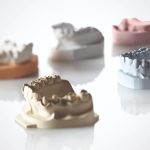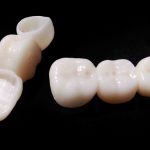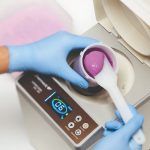
Thanks to new developments in materials, modern dentistry is undergoing a true methodological revolution. In that context, the evolution of materials and adhesive systems is having an impact on the restorative approach to the posterior elements, considerably modifying the treatment plan. (1,2)
Adhesive rehabilitation of the posterior teeth is driven not only by aesthetic concepts but also by bioeconomic principles and biomechanical concepts, according to which it is possible to perform a rehabilitation capable of strengthening the remaining tooth structure. (3)
Classifying partial restorations of posterior teeth: inlay, onlay and overlay
Partial restorations of posterior teeth can be classified as inlays (without cusp coverage), onlays (coverage of at least one cusp) or overlays (covering all the cusps). (4)
These partial restorations allow maximum preservation of the residual dental structure, promote the reinforcement of the compromised element and re-establish masticatory, phonetic and aesthetic function. (4)
Currently, a wide variety of resinous or ceramic materials are available for the fabrication of indirect partial restorations. (5,6)
Methods and materials for indirect partial restorations
Resin inlays, onlays and overlays can be manufactured in the laboratory using different methods that may involve different types of polymerisation (chemical, thermal and photo-polymerisation) or using CAD/CAM milling methods starting from prefabricated resin blocks. (7)
The ultimate strength of these materials derives primarily from the degree of monomer conversion and the quantity and quality of inorganic filler present. (4)
These rehabilitations can also be based on feldspathic, crystalline or glass ceramics and be made traditionally according to stratification or using CAD/CAM methods of milling from blocks.
Ceramic restorations: strengths and complications
Ceramic restorations, in comparison with composite ones, have better resistance to abrasion (despite being more abrasive) and a greater resistance to compression. (8,9)
By definition, however, ceramics represent a certain degree of fragility; in other words, a ceramic material, if subjected to high stress, is unable to show any degree of deformation, but will tend to fracture instead. (8)
Based on current evidence, the survival over time of partial ceramic and composite restorations appears to be high in both cases. (8)
The complications that most frequently lead to the failure of this type of rehabilitation are biological for composite restorations (secondary cavities or endodontic problems), and mechanical for ceramic ones (chipping and fractures). (8)
Indications for indirect inlays, onlays and overlays
Current indications for adhesive indirect partial restorations are: (1)
- Extensive second-class cavities with cusp coverage (one or more);
- Restoration of large occlusal surfaces compromised by abrasion/erosion.
These indications are reinforced by some cofactors such as: (1)
- The presence of a small amount of cervical enamel (less than 1 mm in height and 0.5 mm in thickness), or its complete absence;
- The presence of a cervical concavity;
- The need to perform multiple restorations in different quadrants, with the consequent modification of the general occlusal structure;
- The need to re-establish or increase the vertical dimension.
The advantages of the indirect restorative approach
An indirect restorative approach, compared to a direct one, makes it possible to obtain an ideal occlusal anatomy with excellent control of contact points and emergence profiles, as well as the option of evaluating the occlusion by mounting the restoration in the articulator. (1)
Furthermore, polymerisation shrinkage is drastically limited, improving the marginal seal.
Inlay, onlay, overlay: principles of preparation
The principles for preparing this type of restoration depend first and foremost on the type of material that we intend to use for the definitive restoration.
It is necessary to respect the minimum thicknesses and manage the peculiar biomechanical characteristics of the material in question. (10,11)
It is also vital to pay attention to the location of the cavity margins. If necessary, they can be relocated by raising the cervical step, but if the extension of the cavity reaches the point of invading the biological width, the clinical crown must be extended. (10,11)
It is also useful to carry out a careful evaluation of the thickness of residual enamel: if this proves too small, removal and greater cuspal covering would be advisable, in order to guarantee a better prognosis for the restoration and the residual dental support structure. (10,11)
References
1) Veneziani, M. (2017). Posterior indirect adhesive restorations: updated indications and the Morphology Driven Preparation Technique. Int J Esthet Dent, 12(2), 204-30.
2) Nathanson D. Current developments in esthetic dentistry. Curr Opin Dent 1991;1: 206–211.
3) Liebenberg WH. Posterior composite resin restorations: operative innovations. Pract Periodontics Aesthet Dent 1996;8: 769–778.
4) Morimoto, S., Rebello de Sampaio, F. B. W., Braga, M. M., Sesma, N., & Özcan, M. (2016). Survival rate of resin and ceramic inlays, onlays, and overlays: a systematic review and meta-analysis. Journal of dental research, 95(9), 985-994.
5) Thordrup, M., Isidor, F., & Hörsted-Bindslev, P. (2006). A prospective clinical study of indirect and direct composite and ceramic inlays: ten-year results. Quintessence international (Berlin, Germany: 1985), 37(2), 139-144.
6) Pol, C. W., & Kalk, W. (2011). A systematic review of ceramic inlays in posterior teeth: an update. International Journal of Prosthodontics, 24(6).
7) Kildal, K. K., & Ruyter, I. E. (1994). How different curing methods affect the degree of conversion of resin-based inlay/onlay materials. Acta Odontologica Scandinavica, 52(5), 315-322.
8) Fan, J., Xu, Y., Si, L., Li, X., Fu, B., & Hannig, M. (2021). Long-term clinical performance of composite resin or ceramic inlays, onlays, and overlays: a systematic review and meta-analysis. Operative Dentistry, 46(1), 25-44.
9) Mörmann, W. H., Stawarczyk, B., Ender, A., Sener, B., Attin, T., & Mehl, A. (2013). Wear characteristics of current aesthetic dental restorative CAD/CAM materials: two-body wear, gloss retention, roughness and Martens hardness. Journal of the mechanical behavior of biomedical materials, 20, 113-125.
10) Dietschi, D., & Spreafico, R. (2015). Evidence-based concepts and procedures for bonded inlays and onlays. Part I. Historical perspectives and clinical rationale for a biosubstitutive approach. Int J Esthet Dent, 10(2), 210-27.
11) Rocca, G. T., Rizcalla, N., Krejci, I., & Dietschi, D. (2015). Evidence-based concepts and procedures for bonded inlays and onlays. Part II. Guidelines for cavity preparation and restoration fabrication. Int J Esthet Dent, 10(3), 392-413.
Would you like more information about Zhermack Dental products and solutions?
Contact us




 Zhermack SpA has been one of the most important producers and international distributors of alginates, gypsums and silicone compounds for the dental sector for over 40 years. It has also developed solutions for the industrial and wellbeing sectors.
Zhermack SpA - Via Bovazecchino, 100 - 45021 Badia Polesine (RO), Italy.
Zhermack SpA has been one of the most important producers and international distributors of alginates, gypsums and silicone compounds for the dental sector for over 40 years. It has also developed solutions for the industrial and wellbeing sectors.
Zhermack SpA - Via Bovazecchino, 100 - 45021 Badia Polesine (RO), Italy.


